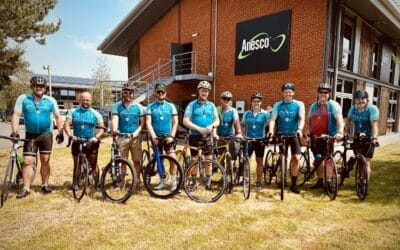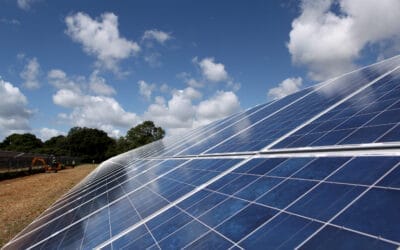Hildagarde McCarville, CEO of Anesco, explores the company’s role as a pioneer of solar and storage, and why people must sit at the heart of the energy transition
Since being founded in 2010, Anesco has been committed to enabling the energy transition and ensuring energy security, through the deployment of affordable solutions that support net zero.
We do this in two ways; by developing, designing, constructing and operating solar and battery storage assets; and by supporting local authorities to improve the energy efficiency of homes through the ECO and GBIS initiatives.
To date, we have been responsible for 147 solar and battery storage plants, totaling more than 1GW, across the UK and Northern Europe.
A global solution
Solar has a vital role to play in the energy transition with a UK government target of 70GW by 2035 representing a five-fold increase of capacity deployed to date.
Globally, the popularity of solar continues to soar with technology advancing at pace – increasing in efficiency, while reducing in price. This has seen solar become the ‘cheapest source of electricity in history’.
It takes less than one hectare of land per megawatt of power generated by solar farms meaning that installed solar to date occupies just 0.1% of total land across the UK. To put that into context, golf courses utilise seven times the space.
Anesco’s first solar farm, installed in 2012 – a 5MW plant in Dorset – was a ground-breaking achievement for its time. Flashforward a decade and we recently constructed a 73MW solar farm, capable of generating the power needs of around 28,000 homes!
Anesco was also a first market mover of battery energy storage (BESS) technology in the UK. We have long recognised the vital role that BESS will play in countering the intermittent nature of solar and how, when co-located alongside solar installations, it can help accelerate the adoption of solar.
Supporting biodiversity
As well as generating sustainable electricity, something that is often overlooked when it comes to solar farms is their benefit for biodiversity. In Britain, wildflower meadows have decreased by 97% since the 1930s, largely due to population growth and intensive farming. Consequently, key pollinators, such as bees are in decline, affecting the environment and the economy – pollinators are worth €153bn annually.
As an active member of Solar Energy UK, and with the support of the National Farmers Union (NFU) and RSPB, at Anesco we ensure our solar farms achieve the maximum positive environmental impact, by providing habitats for at-risk birds and wildlife and boosting native flora. Some of our recent sites have hit a 100% biodiversity net gain.
Challenges to growth
One key barrier to solar growth is the transmission system, which was designed to support the central power generation model we have traditionally followed (not decentralised, intermittent generators like renewables). What this means is that projects that could be constructed in 2024 may be waiting until 2037 for a connection date.
While reforms aimed at “freeing up over 100GW of capacity so that projects can connect sooner” are very welcome, as is the establishment of the UK Solar Taskforce, this remains a huge threat to the UK’s net zero target.
Another crucial factor in the long-term growth of renewables is investor confidence. As well as developing and building high performing solar and storage assets, one way we are driving investor confidence is through data. Our inhouse data analysts and scientists leverage the experience of our onsite engineers and technicians, using operational data from the thousands of sites we manage. This data means we are not only able to respond to changes in system frequency that require an asset to respond within a second, but we can support investors to ensure the highest availability, yield and economic returns.
People power
While renewable technologies offer a solution to net zero and energy security, it is people that ultimately sit at the heart of the energy transition. Investing in training and career development, encouraging innovation, and inspiring the next generation, are all-important pieces of the puzzle.
When we build a new asset, there can be 150 people deployed on the project at any one time, from electricians, to site managers, equipment installers, engineers, safety advisors and national grid staff. We work closely alongside our suppliers to ensure the success of the project by committing to and upholding compliance, safety and quality standards and driving technical innovation, all as part of a continuous closed loop process.
As strong believers in the UN Sustainable Development Goals and Policy of Zero Harm, we are an active proponent of the Solar Stewardship Initiative (SSI), which aims to further develop a responsible, resilient, transparent, and sustainable solar value chain.
The next generation
As for our team, whilst we have over 350 years of construction experience amongst our employees, 46% of our workforce is under 35.
Representation matters and Anesco has its own Young Professionals Network, which alongside the leadership team, has helped develop and drive our ESG programme, graduate recruitment initiative and corporate values, and is spearheading our digital strategy.
In addition, we’re a member of the Solar Trailblazer Group, which is developing a standard for apprentice qualifications, thus attracting young people into the sector and ensuring sustainable career paths.
We believe that with a committed and skilled workforce, the right technologies, and the right policies, together we can achieve a prosperous future of sustainable growth.
This article was originally published by Open Access Government.







